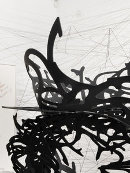Other modernist painters like Picasso, Marcel Duchamp and Kazimir Malevich became fascinated with the idea of a higher fourth dimension — not the dimension of time that, through Einstein’s general theory of relativity, was merged with three spatial dimensions into space-time, but a fourth dimension of space, said Linda D. Henderson, a professor of art history at the University of Texas at Austin and the author of “The Fourth Dimension and Non-Euclidean Geometry in Modern Art.”
The theme arose from popular interest at the end of the 19th century with advances in geometry, the discovery of X-rays, and the 1884 publication of Edwin Abbott Abbott’s influential book “Flatland: A Romance of Many Dimensions,” an allegory of life in two dimensions.
“It becomes a huge cultural preoccupation,” Dr. Henderson said, “the idea that the human retina is seeing just a fraction of the electromagnetic spectrum, and that our world might be like Flatland or Plato’s cave, a shadow of a complex four-dimensional reality.”

